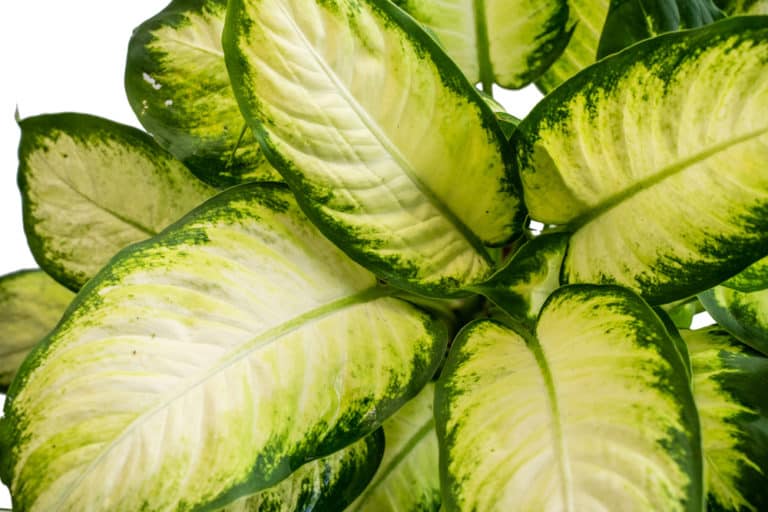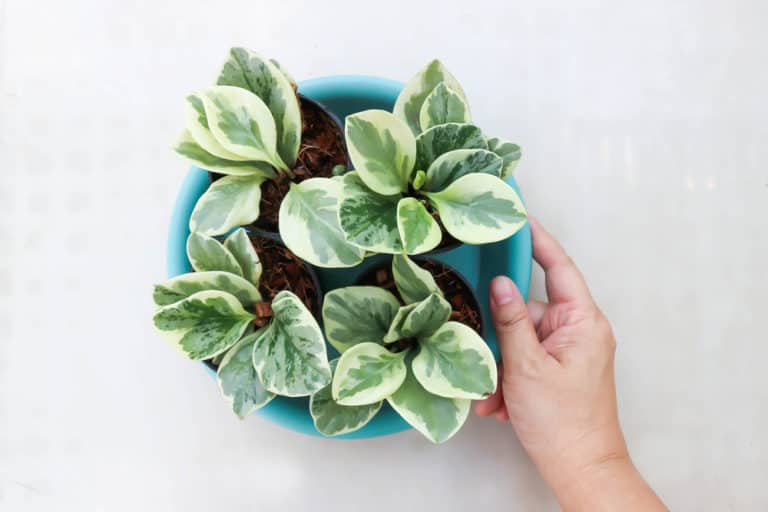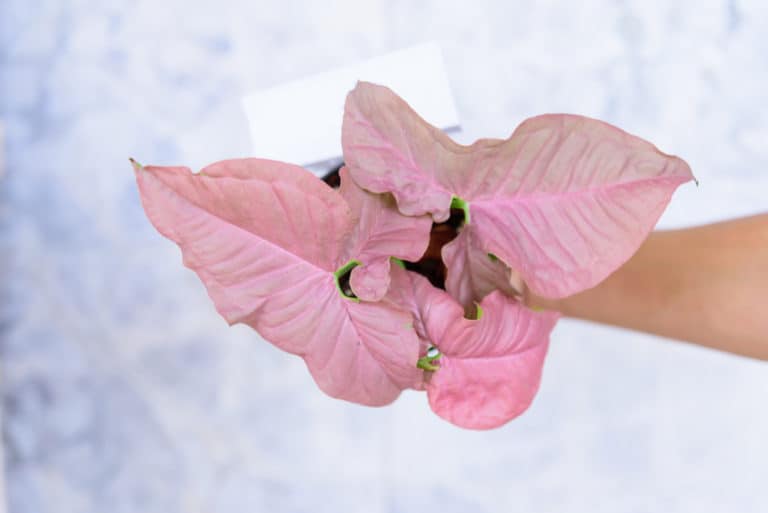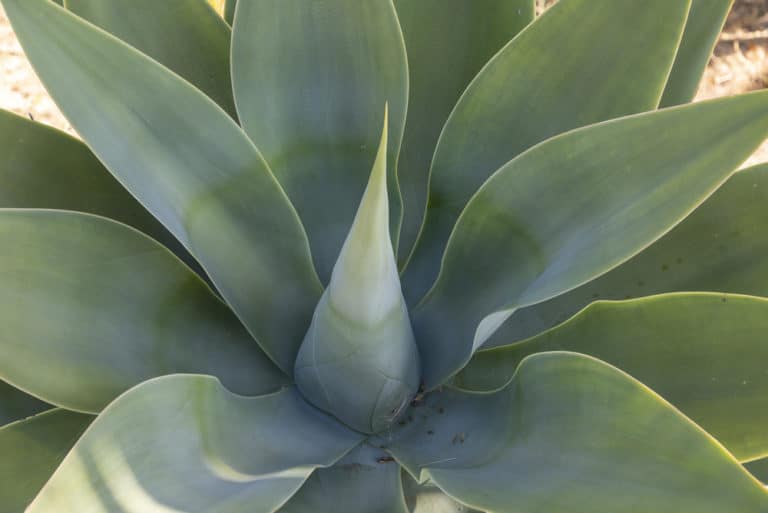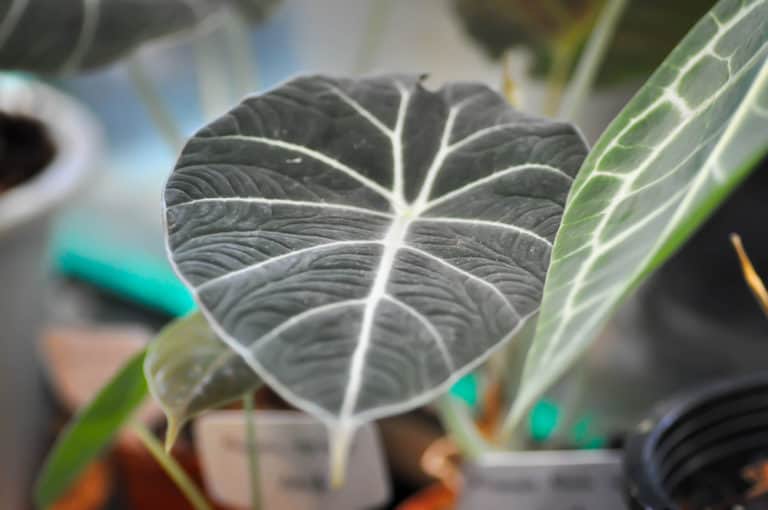Philodendron Melanochrysum x Verrucosum ‘Splendid’ (2024)
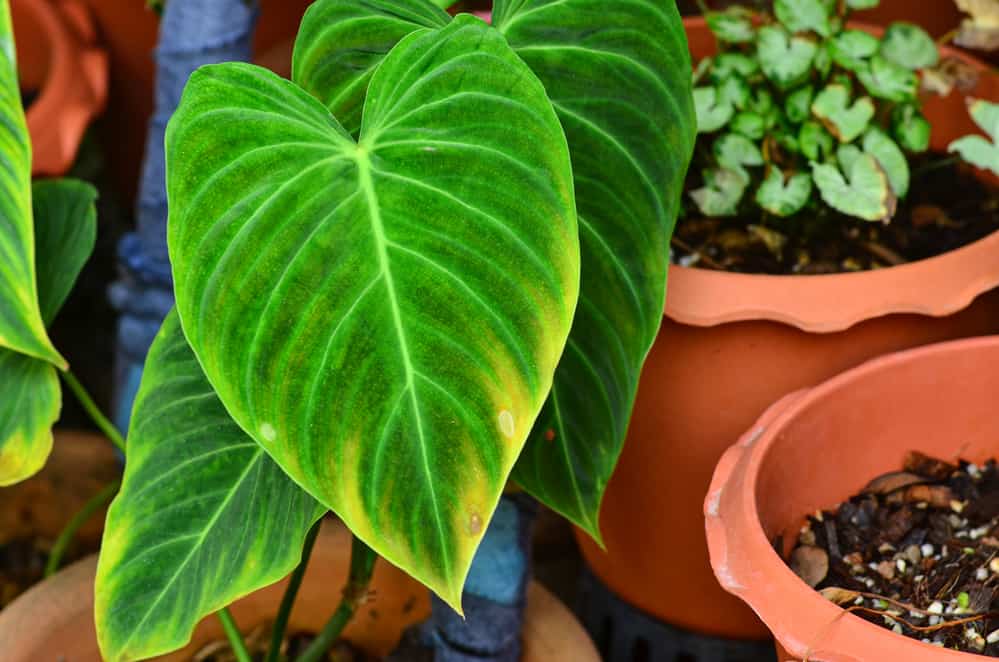
Philodendron Splendid is instantly recognizable by its huge, velvety leaves and commanding size, even when grown indoors.
Rare and expensive, it’s prized by plant collectors.
You won’t have room for a Philodendron melanochrysum x verrucosum in a tiny home or studio apartment.
However, where you’ve got the space, this magnificent tropical beauty is worth the price.
| Scientific Name | Philodendron melanochrysum x verrucosum |
| Common Name | Philodendron Splendid |
| Light | Bright indirect sunlight |
| Watering | Water if the top half of the soil is dry |
| Temperature | 65 to 85ºF (18 to 29ºC) |
| Hardiness Zone | 10 to 12 |
| Humidity | 60 to 90% |
| Soil Type | Rich, quick-draining, loamy |
| Soil pH | 5.5 to 6.0 (acidic) |
| Fertilizing | Once a month in spring and summer |
| Repotting | Every 2 to 3 years |
| Pruning | Early spring |
| Propagation | Root in water or soil |
| Toxicity | Toxic to humans and pets |
| Mature Size | 4 to 6 feet as a houseplant |
| Bloom Time | Rarely flowers indoors |
What’s Unique About Philodendron Splendid?
The Philodendron Splendid plant is a modern hybrid, a cross between the two parent plants that gave it its scientific name, Philodendron melanochrysum x verrucosum. Those parents are native to the rainforests of Ecuador, along the equator.
It was developed in the 1980s in Australia, and only named in 2018, so it’s really a newcomer to the home gardening scene.
Growing Philodendron Splendid can be a little challenging, and you will definitely need room to let it spread.
However, the huge, glorious velvety leaves are worth any trouble you may encounter along the way.
And not only is it beautiful, but it even cleans your air as it grows!
Philodendron Splendid Care
While Philodendron Splendid plants have never grown in the tropical rainforests, Philodendron Splendid plant care is the same as for their wild ancestors.
On the forest floor where the philodendron family originates, they grow in a warm, humid atmosphere in the dappled shade of the tree canopy.
Good Splendid plant care should replicate those conditions in your home.
Light
In the tropical rainforests of Ecuador, philodendrons are not exposed to the bright equatorial sun. The tree canopy filters the rays before they get to the forest floor.
In your home, Philodendron Splendid light requirements are for bright, indirect light, or 10,000 to 20,000 lux.
Usually you will not need special grow lights to meet your Splendid plant light needs.
You can place your Philodendron Splendid close to a north or east-facing window, or several feet away from a south or west exposure.
At all costs avoid putting your Philodendron Splendid in the full sun, as that will damage those gorgeous leaves.
However, in winter in temperate zones you may find that you need to move your Philodendron Splendid to a south window to get more light when days are short.
Watering
In the rainforest, philodendrons grow in soil with lots of organic matter. It retains some moisture but also has an open, spongy structure that drains easily.
Your Philodendron Splendid watering needs to keep the soil a little moist at all times, without it ever being saturated.
Water Splendid plant whenever the top half of the soil has dried out. You may need a moisture meter to determine this as the plant grows in size.
Philodendron Splendid watering needs are best met with distilled water, as tap water contains chemicals such as fluoride and chlorine that can damage the plant.
If you have no choice, let it sit overnight in an open container to let the chemicals dissipate.
Temperature
The usual Philodendron Splendid temperature range is 65 to 85ºF (18 to 29ºC).
The best temperature for Splendid plant is towards the top end of that range, as you would expect for a tropical plant.
Even in temperate zones, you should be able to move your Philodendron Splendid outdoors to bask in some hot, humid summer weather.
Philodendron Splendid has limited temperature tolerance below 55ºF (12ºC), and will start to suffer some foliage damage below that.
As well, it has no frost hardiness at all. Protect your velvety tropical beauty from anything even close to freezing temperatures at all times.
Humidity
The tropical rainforest is a steamy place, and so Philodendron Splendid humidity requirements are high, even if this hybrid has never grown there.
The ideal humidity for Splendid plant is between 60 and 80%, which is a higher humidity level than you will want to keep your whole house at. You will need to create a humid microclimate for Philodendron Splendid and your other tropical plants.
Misting is not recommended, because the unique velvety texture of the leaves can be marred by water droplets, as well as fostering disease.
You can set a pebble tray under the pot to keep humidity a bit higher in its immediate vicinity, but the best solution is to invest in a small humidifier to set amongst your tropical plants.
Soil
Philodendron Splendid soil needs to have lots of organic matter and drain well, just like in the rainforest.
If the soil remains saturated, it will cut off oxygen to the roots and eventually kill your plant.
The best pH level for Splendid plant is 5.5 to 6.0, or acidic.
A simple soil for Splendid plant is just 100% peat moss. It’s acidic enough to satisfy the pH requirements, and will provide excellent drainage.
You can also make a soil mix with equal parts of potting soil, orchid bark, and perlite.
It’s also possible to buy a commercial aroid soil which will not need any amendments.
Fertilizer
Philodendron Splendid fertilizer should be used to support the optimal growth of its large, beautiful leaves.
To that end, you should use a nitrogen-rich fertilizer for Splendid plant with a fertilizer ratio of 2-1-1 or 3-1-1.
If you can’t easily find that, settle for a balanced ratio, which should work fine. Liquid fertilizer is the easiest to use.
Dilute the fertilizer to half its recommended strength and apply evenly over the soil surface once a month in spring and summer.
Always do this right after you’ve watered the soil to ensure full absorption.
Don’t use fertilizer during Philodendron Splendid’s dormant period in fall and winter.
Potting & Repotting
You should plan on Philodendron Splendid repotting every 2 or 3 years, but keep an eye on the pot to see if it’s necessary sooner than that.
It’s time for repotting Splendid plant when the roots start to take over the pot, coiling around the insides and growing out the drainage holes.
Early spring is the best time to do it.
If you’ve got a rootbound Philodendron Splendid, go up one pot size only. Too much soil can result in watering issues and harm the plant.
Always use fresh potting soil. In fact, if it’s been 3 years and you still aren’t seeing root issues, you should still repot your Philodendron Splendid just to refresh the soil.
Pruning
Philodendron Splendid pruning can be done in early spring to shape the plant or limit its height.
You will also want to cut out dead or damaged leaves whenever they occur during the year.
When cutting Splendid plant leaves, take out the entire stem to just above the soil level. Cut the stem on a 45 degree angle so that water will not collect on top of the stump and foster disease.
If you cut just above a node, that will encourage new growth.
You can also trim around the margins of leaves. Since these leaves are so big, you don’t want to lose the whole thing if it’s just some minor damage.
Use very sharp, small scissors to cleanly cut away the affected edges.
Propagation
The best method of Philodendron Splendid propagation is by rooting stem cuttings in soil or water.
To propagate Splendid plant, start by taking a 4 to 5 inch length of stem with at least 1 node. Cut just below the lowest node. Strip off all but the top leaves.
Set the cuttings aside for a week to let the cut end heal over, or form a callous.
Then, either put the stem cuttings in a jar of water or moist soil. Keep them humid with either a plastic bag or a water jug with the bottom cut off covering the whole thing.
Within a month or two you should have healthy plants to pot up.
Also, make sure to check out our in-depth Philodendron squamiferum plant care guide.
Common Problems of Philodendron Splendid
Like with all houseplants, you may encounter some Philodendron Splendid problems, especially if its growing conditions are less than ideal.
For the most part, problems with Splendid plant can be easily diagnosed and solved.
The leaves will usually let you know if there’s something wrong,so just keep an eye on them.
Pests
Those big, gorgeous leaves aren’t just attractive to you, but also to Philodendron Splendid pests.
Wipe down or spritz your Splendid plant every month with insecticidal soap or neem oil to deter bugs.
Aphids may congregate on the juicy stems or the underside of the leaves. Use a hand vacuum to gently remove them.
Mealybugs can be found in their fluffy white colonies under the leaves. Use a cotton ball soaked in rubbing alcohol to remove them.
Spider mites leave little yellow bumps, and sometimes spin sticky webs. You shouldn’t hose down the leaves, so wipe down the underside with rubbing alcohol.
Diseases
The good news is that you can usually avoid any Philodendron Splendid diseases simply by controlling moisture.
While your Splendid plant revels in high humidity, actually having wet leaves or soaked soil will foster fungal and bacterial disease.
Root rot is the most common disease, which is much more likely when you overwater your Philodendron Splendid. Less is more when it comes to watering these plants.
When leaves turn yellow and stems start to wilt, and the roots are getting black and smelly, you might still be able to rescue your precious Philodendron Splendid. Cut out all affected parts and repot in fresh soil in a disinfected pot.
Leaf spot can be caused by a bacterial or fungal disease. Cut off all infected leaves and spray with a fungicide.
Growing Problems
You may encounter growing problems which are not caused by bugs or disease, and these are the easiest to resolve.
Just improving its growing conditions should restore your sick plant to vigorous health.
Brown leaf tips and margins may mean that the humidity is too low, or that your Philodendron Splendid is getting too much sun.
Curling or drooping leaves can be a symptom of underwatering or overfertilization.
If the soil is adequately moist, you should try flushing out excess fertilizer by running a steady stream of water through the soil. After about 10 minutes, let the soil drain completely.
Toxicity of Philodendron Splendid
Splendid plant is toxic to humans and animals.
Its toxicity is due to the calcium oxalate crystals, or raphides, found in all parts of the plant. The tiny sharp crystals pierce delicate tissues and can cause painful reactions.
If you want to keep a Philodendron Splendid in the same house as children and pets, you should take common sense precautions to keep them safe.
For Humans
Philodendron Splendid is toxic to humans.
Adults are most likely to encounter problems when the sap gets on your skin, as it can trigger a rash. Just rinse any off thoroughly if you are exposed.
Children, however, may sometimes try to eat the foliage. They will experience immediate pain from the raphides, so are unlikely to persist beyond an initial nibble.
Get them to rinse and spit, and wash any bits of leaf off of their face. If all they have is localized pain in their lips and mouth, just give them something cold to numb the pain.
However, a swollen tongue or obstructed airway is a more serious situation, and you should take them to the emergency room.
For Pets
Philodendron Splendid is toxic to all household pets, including cats, dogs, and rabbits.
Cats especially are notorious for wreaking havoc on houseplants, and unfortunately Philodendron Splendid will bite back.
If your pet has vomiting, diarrhea, wheezing, or excessive drooling, take it to the veterinarian as soon as possible.
While your Philodendron Splendid is small, you should be able to keep it out of reach on a shelf or table, but once it reaches its full size, that’s not an option.
You may be able to use a decorative trellis to screen off the Philodendron Splendid pot at ground level to keep it and your pets safe.
Philodendron Splendid Appearance
The Philodendron Splendid appearance is pretty well summed up by its name. It is truly splendid.
The huge, gorgeous velvety leaves will create a luxurious, tropical atmosphere wherever this spectacular foliage plant is used.
Its classic good looks, rich texture, and dramatic coloring are equally well-suited to a modern or traditional setting.
Foliage
The foliage of Philodendron Splendid is almost too good to be true.
A Philodendron Splendid leaf will grow to the huge size of 2 feet long and 1 foot across, with a heart-shaped form ending in an elongated tip.
The top of the leaves have a soft, velvety texture. New leaves are brownish red when they first unfurl, maturing to a deep green with bronze tones.
The contrasting veins are white or bright green. The underside is a deep red-purple.
The velvety texture will be a dust magnet; once a month, give every leaf a gentle wipe-down with a barely damp cloth.
Flowering
While Philodendron Splendid flowering is very unlikely on a potted plant grown indoors, you may be lucky enough to see a Splendid plant flower outdoors.
Blooming is possible after 10 to 15 years on a Philodendron Splendid plant grown outdoors in the ground in a tropical climate.
Flowering only lasts for a few days in summer, if and when it does occur.
The flower has a thick white spadix wrapped in a green and white spathe, with a sweet scent.
While it’s always fun to see a plant bloom, the Philodendron Splendid flower is nothing compared to its spectacular foliage.
Size and Growth
The full size of Philodendron Splendid grown indoors is between 4 to 6 feet, while a plant grown outdoors in a tropical zone can be 10 feet or more in height.
Because of the size of its leaves, it will take up a lot of space, so you won’t be able to accommodate it in a small room.
Philodendron Splendid has a moderately fast growth rate, taking about 5 years to reach its full size.
It will grow faster when staked with a sphagnum moss pole. Its aerial roots can grab onto the organic matter, encouraging more vigorous leaf growth.
Philodendron Splendid Fragrance
For the most part, you should not expect to detect any Philodendron Splendid fragrance.
While the flowers have a sweet scent, any plant grown indoors is not going to bloom, and even when outdoor Philodendron Splendids do flower, it’s only for a couple of days once a year.
However, as an indoor gardener you can still expect benefits from growing Philodendron Splendid.
Like all aroids, it naturally filters chemicals such as formaldehyde, which are common in modern homes.
Fragrance-free houseplants are also recommended for public settings such as stores and medical facilities, as many people have fragrance sensitivities or allergies.
Suggested Uses for Philodendron Splendid
Philodendron Splendid is a magnificent, rare plant that you are going to want to show off to its best advantage wherever you use it.
Indoors, the beautiful, velvety foliage will either be the perfect backdrop for houseplants with vivid flowers, or can stand alone as an accent plant in any space.
You can’t tuck it into a small nook, but where you’ve got the room to let it spread its leaves, it will be a focus of attention.
Move it outdoors to a patio or balcony in summer to instantly create a tropical getaway and let it enjoy the heat and humidity.
FAQ
What is Philodendron Splendid?
Philodendron Splendid, or Philodendron melanochrysum x verrucosum, is a philodendron hybrid developed in Australia in the 1980s. It is a rare and highly prized tropical houseplant.
How to identify Philodendron Splendid?
Philodendron Splendid has heart-shaped dark green leaves with a distinctive velvety texture, growing to 2 feet long and one foot across on a tall climbing vine.
How to care for Philodendron Splendid?
Philodendron Splendid should be grown in bright, indirect light in porous soil, in a warm and humid environment. Water when the soil is half dry and fertilize monthly.
How to grow Philodendron Splendid indoors?
Philodendron Splendid can be grown as a potted plant with high heat and humidity, kept out of the full sun and watered just enough to keep the soil moist.
How to grow Philodendron Splendid outdoors?
Philodendron Splendid can be grown outdoors year-round in zones 10 to 12, or moved outside to a shady spot in the summer in temperate zones.
How fast does Philodendron Splendid grow?
Philodendron Splendid has a moderately fast growth rate and will take 5 years to reach its full size indoors. Outdoors a plant may reach its mature phase in 10 to 15 years.
How tall does Philodendron Splendid grow?
Philodendron Splendid will grow to between 4 to 6 feet tall as a climbing vine indoors, while a plant grown outdoors in a tropical climate can be 10 feet long.
How to make Philodendron Splendid grow faster?
Philodendron Splendid will grow faster when provided with consistently high heat and humidity, with regular light watering and fertilizing. Staking it with a moss pole will also speed growth.
How to stake Philodendron Splendid?
Philodendron Splendid should be staked with a sphagnum moss pole to give its aerial roots something to grab onto for strong vertical growth and support for the large leaves.
How to pot Philodendron Splendid?
Philodendron Splendid should be repotted every few years in loose, porous soil with plenty of organic matter, in an unglazed clay pot with good drainage holes.
How to revive Philodendron Splendid?
If your Philodendron Splendid has completely dried out, set the pot in a pail of tepid water and let the soil completely absorb the water before letting the excess drain out.
Why is my Philodendron Splendid dying?
Your Philodendron Splendid may have a disease from too much moisture in the soil or on the leaves. Keep water off the leaves and only water when the soil is half dry.
Why is my Philodendron Splendid drooping?
Your Philodendron Splendid may be getting too much or too little water. Either give it a thorough soaking or replace the sodden soil with a fresh, porous mix.
How cold can Philodendron Splendid tolerate?
Philodendron Splendid will be harmed by temperatures below 55ºF (12ºC), and freezing temperatures will kill it. Keep it out of drafts and away from cold windows.
How to get rid of pests on Philodendron Splendid?
Philodendron Splendid pests can usually be controlled with regular spraying or wiping down of the leaves with organic solutions such as insecticidal soap or neem oil.
Is Philodendron Splendid toxic to cats?
Yes, Philodendron Splendid is toxic to cats. If your cat starts vomiting or wheezing after ingesting foliage, take it to the veterinarian as soon as possible.
Is Philodendron Splendid toxic to dogs?
Yes, Philodendron Splendid is toxic to dogs. If your dog has diarrhea or vomiting, excessive drooling or difficulty breathing, take it to the vet immediately.
Is Philodendron Splendid toxic to children?
Yes, Philodendron Splendid is toxic to children. If your child eats some foliage and develops a swollen tongue or constricted airways, go to the emergency room.
Is Philodendron Splendid toxic to humans?
Yes, Philodendron Splendid is toxic to humans. The irritating sap can cause a rash to develop. If it gets on your skin, rinse it thoroughly.
Does Philodendron Splendid have a scent?
Philodendron Splendid flowers do have a sweet scent, but they are so rare on indoor potted plants that it is usually considered a fragrance-free foliage plant.

